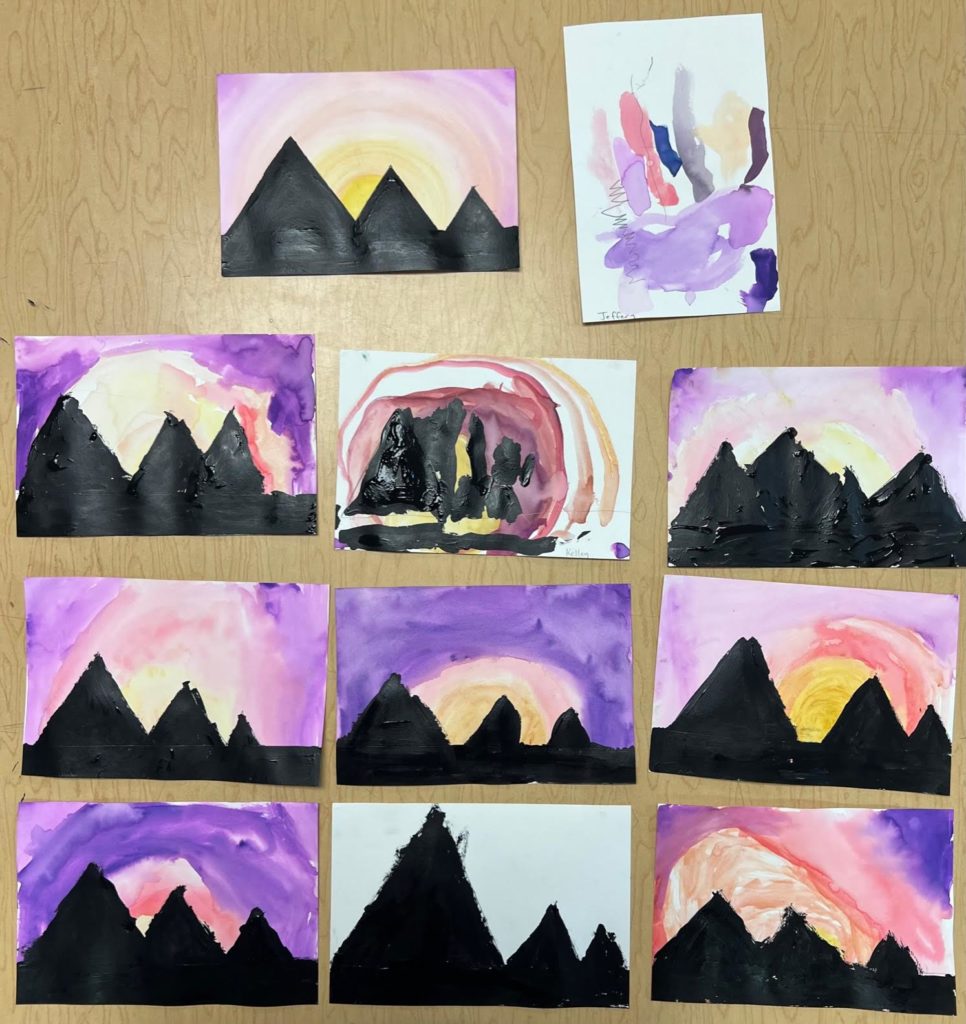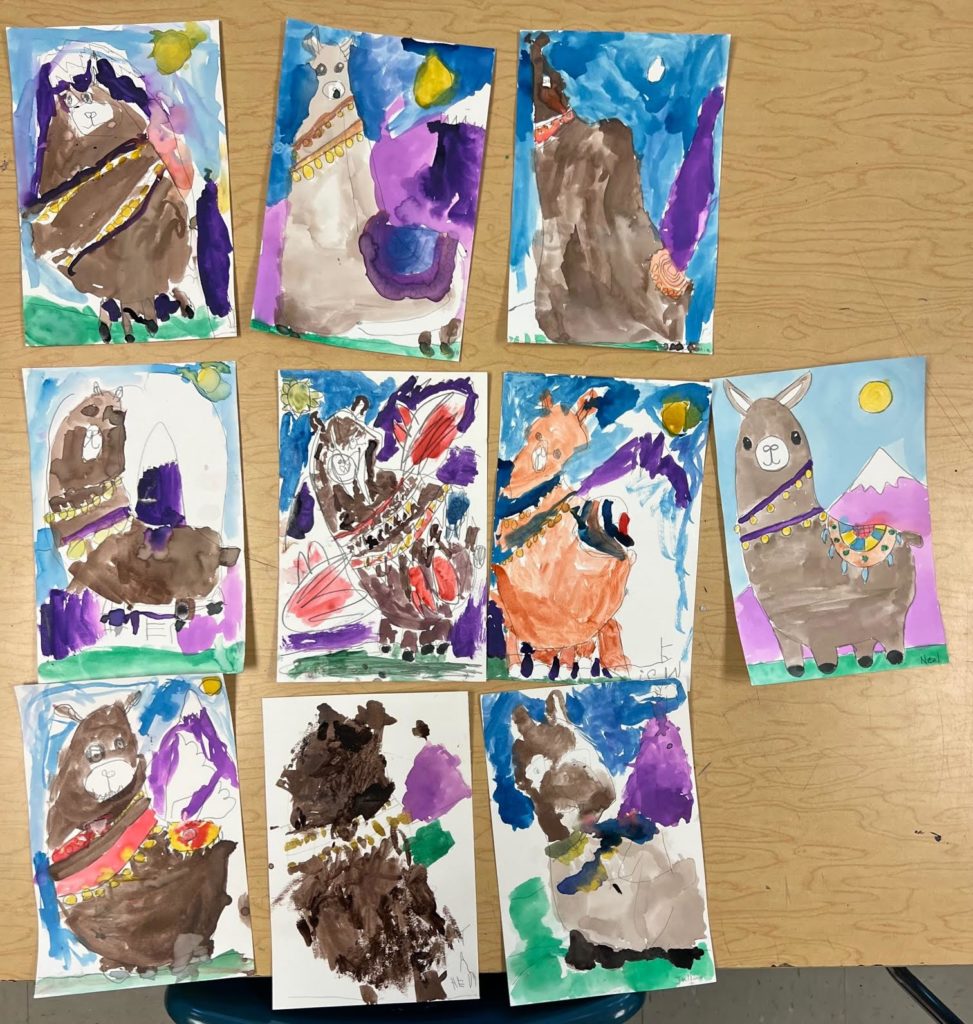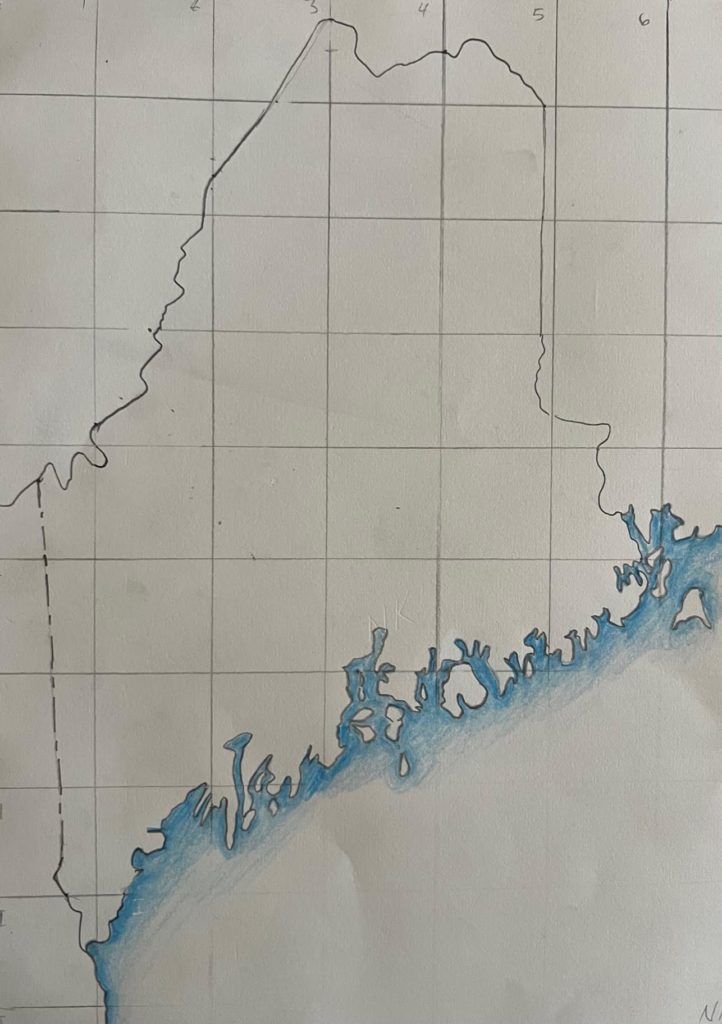
1/2 Egypt…libraries
Puffins/Pre-K Mrs. Gillan and Ms. Newell
We have been practicing our daily routines, and learning our specials teachers’s names and faces and what fun things we get to do with them! In Literacy, we have been making our letters with play-doh, reading and writing them, and trying out the sounds that go with the letters. We love noticing letters that are in our names! In Math, we have been learning about “same” and “different” and using words to help explain how things might not look the same but are still in the same category (like penguins and eagles are both birds!). We are also using our classroom rug to play a version of “Candyland” where we roll dice, count the dots and walk forward that number of spaces. In our social/emotional work, we have been working using brave voices when we would like to play with something, and finding a different work if a friend wants to play alone right now.
K-2 Math- Mrs. Courtot
The K-2 mathematicians have continued to work on their number words, counting by 10’s to 100, ways to make 10 and using our place value chart to count the days in school. Some of the mathematicians worked on making numbers the same and relating addition and subtraction. Others worked on finding the missing values in double digit math equations. Another group worked on finding which group had more and which one had less . The students continued to work on e-spark and also had some fun using Khan Academy Kids. The k-2 mathematicians have been doing warm up activities to transition into math class. These include Which One Doesn’t Belong, Notice and Wonder and Mashed up Math activities. One of the group’s favorites is Est-mystery. They are shown a container with objects in it. They have to estimate or guess how many objects there are. They are given clues and then given an opportunity to change their estimate. The answer is given after the final clue and the students enjoy seeing who gets closer to the correct answer.
Ms. Wilson
This week K-2 writers were assessed on their progress with printing upper and lowercase letters and their full names; students enjoyed making nameplates to practice forming the lower case letters in their names. K-2 writers are learning how to edit sentences by looking for appropriate use of capital letters and punctuation, and identifying different types of sentences.
Pk/K students have continued their study of South America through the Geodes curriculum blended with exploration of the globe and puzzle map of the continents. In the next few weeks will use the text Me on the Map as well as some tangible materials to help students understand how they can live in Brooklin AND Maine AND the United States of America AND North America AND Earth all at the same time!
Donations of reusable water bottles for K-2 students are appreciated, we are using bottled water until the water fountains are safe to use again.

PK/K Llama
Mrs. Ensworth
Morning Meeting: K-2
Every morning our classes meet for a morning meeting. This meeting usually consists of:
Reading a morning message, writing/reading the day’s date, singing good morning songs (many with actions), reading charts (our latest was “September” by, Maurice Sendak), also, we find letters, sounds and words in our charts, a read aloud, learning our birthday month, learning days of the week words and their abbreviations, and many more learning activities.
Reading: Kindergarten
This week we had several days of testing in order to determine students’ reading levels so they could be given appropriate books for our reading lessons. We always review letter names and sounds including the short vowel sounds. We read our reading books together and then have a learning activity to go with the book. Students love to read the book aloud by themselves to the group.
Reading: First Grade
Reading testing for much of the week. We were testing to see how many of the Fry Basic 100 words the students could read. We will continue this testing several times during the year to see the students’ growth in this area. Students were also tested to determine their reading level and were given books to read on their level. We read these books together and in pairs to reinforce reading basic sight words as well as look for reading fluency. Many learning activities were available for children as I was testing individual students. We continue to learn new vowel combinations.
Reading: Second Grade
Several days were dedicated for individual testing for students. Students demonstrated their ability to read words from the 100 Fry words. We are beginning to introduce the second 100 words to second graders. Individual testing to determine students’ reading levels was administered with learning activities for those students waiting to be tested. We continue to learn various vowel combinations and apply them in our reading. Reading for fluency was demonstrated and encouraged. Students read with the group and with partners also at their reading level.
Social Studies: First & Second Grade
This week we “visited” the city of Fez in the country of Morocco, on the continent of Africa. As you can see, we are learning the difference between town/city, country and continents. Students have been introduced to three continents so far: North America, Europe and Africa. Observations have been made regarding differences found in different countries, ie. Language, Art, Architecture, Dress, written words, etc. Students have their own decodable books to read from to learn about new places we visit. The students were very excited to receive their own world map this past week. Social Studies is so FUN!
Band/Music- Mr. Miller
5/6 Band:
We talked about 100% vs 95% accuracy in band and how important it is for all of us to shoot for 100% every time we play. We have been working on our piece “Midnight Mission” and we just started a new piece called “Acropolis”
7/8 Band
We talked about accidentals and key signature this week. Every note can be sharp, natural, or flat, and we have to know when each note is sharp/natural/flat. We are also working on “Midnight Mission” and we started a new piece called “Santa the Barbarian.” We started singing some choir songs called “Bones Aba”, “Hallelujah”, and “Stars I Shall Find.”
In both classes we continue to talk about the importance of practice outside of school. The more we practice at home the more awesome stuff we can play in class!

Art- Mr. Kennerk
PK/K Students followed a step by step drawing instruction to create a rounded, cartoony representation of a llama. Next, we used our watercolor sets and filled in the spaces with vibrant tones. The class is learning about South America in ELA.
1/2 Students painted a sunrise in watercolor moving through the warm colors and curving into the cold purples. Next, we used rulers to create a horizon line and 3 triangles (large, medium, small with a pencil outline. Finally, we filled in our straight-line forms with black acrylic paint to achieve a silhouette of Egyptian pyramids in connection to their ELA focus on libraries around the world (e.g., the Library at Alexandria).
3/4 Students continued on their gridded map of Maine. We finished the Atlantic coastline from the Piscataqua River to the St. Croix River, and then plotted all of the major rivers that empty into the Atlantic Ocean. This project connects to the class’ work with the elements of geography in Super Studies.
5/6 Students considered all of the opposite visual elements when carving name stamps and used light and mirrors to understand that both the form of a letter and the ordered sequence of the letters must be reversed. After many revisions, we carved into rubber to create a name stamp that we will print in the upcoming week.
7/8 Students began a gridded drawing of a portrait of Frederick Douglass. With rulers, we set a grid over a photocopied picture of Frederick Douglass, and we gridded a piece of drawing paper. Then we drew the outline of the human form (shoulders, neck, and hair) within each labelled square. Next, we inserted all of the internal lines designating hairline, facial features, and clothing lines. This project connects with the class’ work in ELA.
Health-Ms. Eaton
PK- We continued our lesson on our 5 senses. We focused on our “hearing” sense and went for a listening walk around the school to label all the noises we hear.
1/2- Students learned about qualities that make a good friend. We talked about the difference between teasing and bullying and how to know if what we are about to say is offensive. We went through different scenarios to discuss if it is a thing a good friend would do or not.
3/4- The students took a quiz regarding food groups. They are learning how to create healthy meal options including a variety of foods from each food group.
5/6- This week we started learning about the food pyramid and food groups. Students discussed why it is important to know what food group foods belong too and who might use nutrition labels to help them in their day to day lives.
7/8- We are continuing our unit on mental health. Students learned about the DSM-5 and used it to choose a mental health disorder to create an individual presentation on. Students will continue to work on these slide show presentations over the next two weeks and then will present to the class.
PE- Ms. Russell
K-4 Practiced skipping, galloping, and jogging while playing Musical Hula Hoops.
5-8 Practiced strategies during a game of Capture the Ball.
ELA with Mrs. Thoner
3/4 ELA
What a great week! Students came to class ready to cooperate and learn!
During the “language” portion of ELA, students continued work on understanding the difference between common nouns, proper nouns, and pronouns; and on identifying and using verbs and adjectives. They took their first formal assessment (pre-test) in this skill this past week. We will continue working on these, as many students perform better orally than they when asked to write the words within the categories.
During the “literature” portion of ELA, students continued to read and listen to our anchor text, Rez Dogs. They wrote an essay analyzing and explaining why they would or would not like to be friends with the main character, Malian. The majority of students are at the very beginning stages of writing for a purpose. Please encourage your child to write at home, whether it be letters to a friend, a story, or whatever else, they all need practice writing.
5/6 ELA
Students have continued their work on reading and comprehending the anchor text, Chains. The book is replete with figurative language of all types! This is a great opportunity for them to become familiar with and identify the various forms of figurative language: simile, metaphor, personification, idiom, alliteration, onomatopoeia, and hyperbole for the purpose of enhancing their own writing. They participated in a pre-test so I, as the teacher, will know what I still need to introduce or review.
Students have also engaged in discussions around racism, culture, and the state of current affairs. Discussions have been informative and open.
7/8 ELA
Each class begins with a Daily Language Arts 5 question introduction/review. Students have been learning how to solve analogies; how to break apart words in order to analyze their meaning; and, how to identify the structure of different sentence types in order to enhance comprehension.
Students have continued reading and analyzing The Narrative of the Life of Frederick Douglass. We have examined various complicated sentence structures and I continually marvel at his impressive use of the English language. Students are working on completing the text and preparing for the final exam on it.
Students will continue to engage in Ellen Writing and in addition to completing all of the expected classwork will be working on their own creative writing pieces with her.
3-8 Math with Mrs. Sproul
3rd grade math –
We are working with understanding multiplication. Students are learning how to look at a real life problem (word problem) and decide if they need to multiply the given numbers or figure out the missing factor. This is very challenging for many and we are spending a bit of time on this as it is foundational for a solid understanding of math. They are continuing working on their fluency with math facts. Please practice with them at home. At this point they should be working with addition and subtraction at home.
4th grade math-
We are diving deeper into fractions and comparing them on to benchmarks like 1/2 and 1. For example is 5/6 bigger or smaller than 1/2 and how close is it to one. We have had some really funny math classes but I think they are starting to truly understand. This is so important for them to fully grasp as all fraction work builds on this understanding. They should be practicing math facts at home. At this point they can do addition, subtraction AND multiplication.
5th and 6th grade math
We are working with fractions and whole numbers with division and multiplication. Students are solidifying their understanding of equivalent fractions and mixed numbers. We are still working on our fluency with math facts and they should be practicing multiplication at home.
7th grade math
We are reviewing ratios which we spent a lot of time on in 6th grade. Students are using ratios in tables and on double number lines. I
8th grade math
The students took a test on rigid transformations and measurements of angles formed by parallel lines cut by a transversal. We are moving into working with dilations.
Algebra
The students took a test on statistics and we have started a new unit. We will be working with linear equations and writing equations for different situations.
Super Studies with Ms. Bebell
7/8 Super Studies
This week, students learned about the history of political parties and wrote about their reaction to George Washington’s opinions on them from his Farewell Address. They also created Venn diagrams to show how today’s Democratic and Republican parties are alike and different. During Forest Day, the class wrote and drew in their nature journals in response to a quote from Henry David Thoreau.
5/6 Super Studies
The students read about and discussed how the geography of Mesopotamia contributed to the development of that civilization and the challenges it created for the people. They also learned about how the first written language developed and then made their own cuneiform tablets in clay to represent their names. On Forest Day, the students wrote silly poems about natural objects in the woods and then practiced realistically drawing their observations.
3/4 Super Studies
This week, the students reviewed and recorded what they learned about electrical energy last week. Then, they explored heat energy by testing the insulation properties of different materials before moving on to an introduction to mechanical energy. On Forest Day, the students practiced identifying organisms around the school using the Seek app on their iPads. They were challenged to identify at least 5 organisms and some kids found many more!

